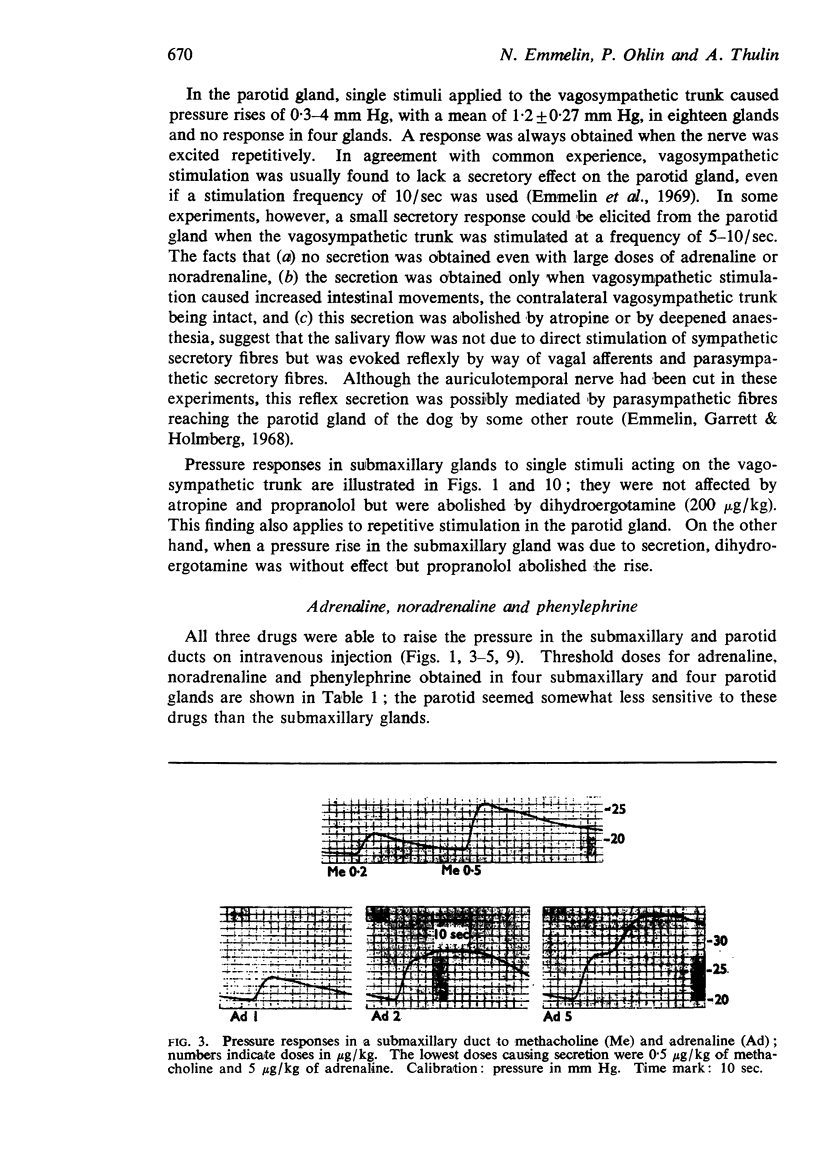Abstract
1. Pressure changes in the submaxillary and parotid ducts of dogs, induced by nerve stimulation or intravenous injection of drugs, were studied.
2. Pressure rises could be elicited by parasympathetic stimulation and by acetylcholine and methacholine, even when no secretion was evoked. These effects were abolished by atropine.
3. Similarly, sympathetic stimulation, adrenaline, noradrenaline and phenylephrine raised the pressure in both glands, also in the absence of secretion. Dihydroergotamine abolished these effects. Isoprenaline increased the pressure in the submaxillary duct, but only when it caused secretion. This effect was abolished by propranolol. In the parotid gland isoprenaline caused neither secretion nor pressure rise. It is concluded that the myoepithelial cells of the two glands are supplied with α-adrenoceptors.
4. Doses of histamine, bradykinin, kallidin and physalaemin which caused no salivary secretion raised the duct pressure even when dihydroergotamine, propranolol and atropine had been given.
5. Angiotensin and 5-hydroxytryptamine increased the pressure only in some experiments. Oxytocin caused very little or no pressure rise. Vasopressin had no effect of its own but reduced the pressure raising effects of nerve stimulation or drugs.
Full text
PDF













Selected References
These references are in PubMed. This may not be the complete list of references from this article.
- BURGEN A. S. TECHNIQUES FOR STIMULATING THE AURICULO-TEMPORAL NERVE AND RECORDING THE FLOW OF SALIVA. Int Ser Monogr Oral Biol. 1964;3:303–307. doi: 10.1016/b978-1-4832-2871-6.50026-6. [DOI] [PubMed] [Google Scholar]
- Bertaccini G., De Caro G. The effect of physalaemin and related polypeptides on salivary secretion. J Physiol. 1965 Nov;181(1):68–81. doi: 10.1113/jphysiol.1965.sp007746. [DOI] [PMC free article] [PubMed] [Google Scholar]
- Bisset G. W., Clark B. J., Haldar J., Harris M. C., Lewis G. P., Rocha e Silva R., Jr The assay of milk-ejecting activity in the lactating rat. Br J Pharmacol Chemother. 1967 Nov;31(3):537–549. doi: 10.1111/j.1476-5381.1967.tb00418.x. [DOI] [PMC free article] [PubMed] [Google Scholar]
- Bisset G. W., Clark B. J., Lewis G. P. The mechanism of the inhibitory action of adrenaline on the mammary gland. Br J Pharmacol Chemother. 1967 Nov;31(3):550–559. doi: 10.1111/j.1476-5381.1967.tb00419.x. [DOI] [PMC free article] [PubMed] [Google Scholar]
- Emmelin N., Garrett J. R., Holmberg J. Uncharted secretory nerves in the parotid gland of the dog. Experientia. 1968 May 15;24(5):460–461. doi: 10.1007/BF02144391. [DOI] [PubMed] [Google Scholar]
- Emmelin N., Garrett J. R., Ohlin P. Motor nerves of salivary myoepithelial cells in dogs. J Physiol. 1969 Feb;200(2):539–546. doi: 10.1113/jphysiol.1969.sp008706. [DOI] [PMC free article] [PubMed] [Google Scholar]
- Emmelin N., Garrett J. R., Ohlin P. Neural control of salivary myoepithelial cells. J Physiol. 1968 May;196(2):381–396. doi: 10.1113/jphysiol.1968.sp008513. [DOI] [PMC free article] [PubMed] [Google Scholar]
- Emmelin N., Holmberg J. The presence of beta-receptors in the submaxillary gland of the dog. Br J Pharmacol Chemother. 1967 Jun;30(2):371–378. doi: 10.1111/j.1476-5381.1967.tb02143.x. [DOI] [PMC free article] [PubMed] [Google Scholar]
- Emmelin N., Lenninger S. The "direct" effect of physalaemin on salivary gland cells. Br J Pharmacol Chemother. 1967 Aug;30(3):676–680. doi: 10.1111/j.1476-5381.1967.tb02174.x. [DOI] [PMC free article] [PubMed] [Google Scholar]
- KAY R. N. The effects of stimulation of the sympathetic nerve and of adrenaline on the flow of parotid saliva in sheep. J Physiol. 1958 Dec 30;144(3):476–489. doi: 10.1113/jphysiol.1958.sp006114. [DOI] [PMC free article] [PubMed] [Google Scholar]


